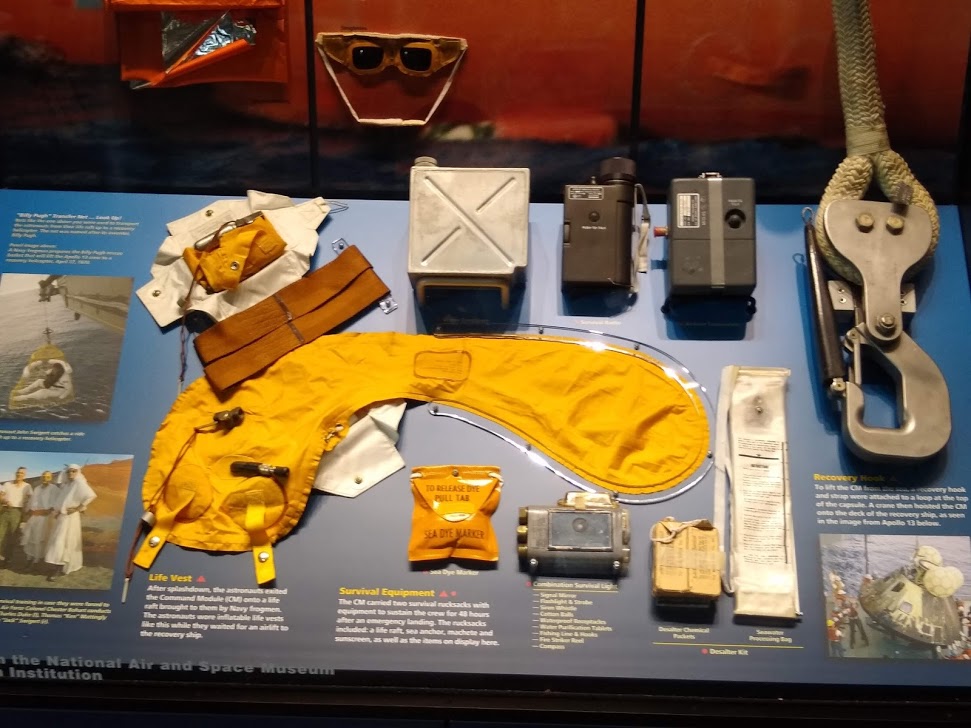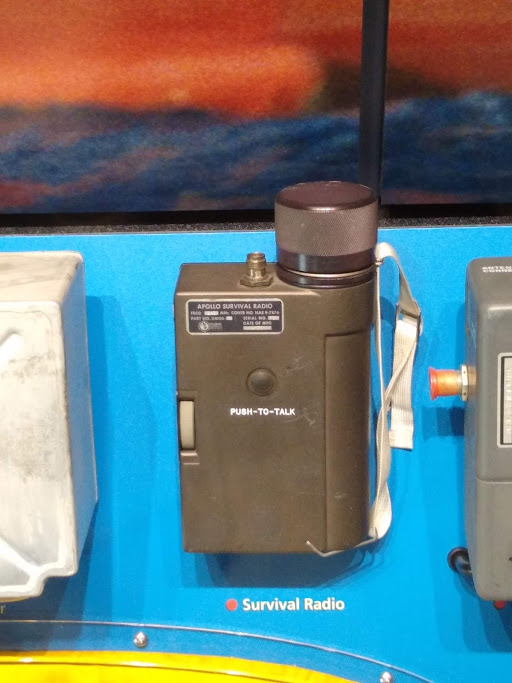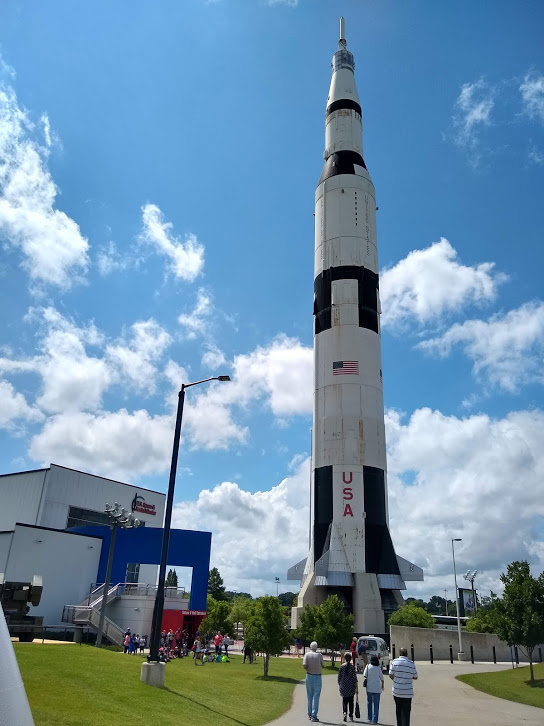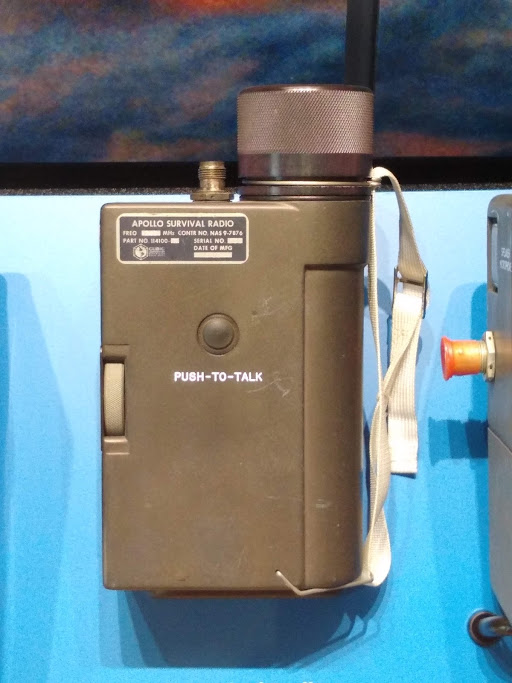In a previous post, I mentioned that I visited the US Space and Rocket Center in Huntsville Alabama last week (a museum I highly recommend to anyone interest in spaceflight).
While perusing numerous displays in the Saturn V Hall at the Davidson Center for Space Exploration, I noted this little radio in a case devoted to Apollo survival gear:

 I found no detailed information about this survival radio at the display (not surprising), so I snapped a few photos and researched it when I got back to the hotel room that evening.
I found no detailed information about this survival radio at the display (not surprising), so I snapped a few photos and researched it when I got back to the hotel room that evening.
The Smithsonian Air And Space Museum was one of the few sources I found with a description of this radio:
Survival gear was provided to Apollo astronauts in the case they returned to Earth and there was a substantial delay in rescue and recovery operations. One item in the survival kit was a hand-held UHF radio. Beginning with the Apollo 12 survival kit the radio beacon was manufactured by the Cubic Corporation. It could operate either as a “beacon” or for two-way voice communications. Permanently set to operate at 243 MHz, the transceiver and its cylindrical battery pack were water-tight. It could operate in beacon mode for up to 24 hours. An extendable antenna, a second battery pack, and a spacecraft connector cable were also provided.
I love finding purpose-designed radios like the Apollo Survival Radio.
Post readers: Have you ever stumbled upon similar survival or purpose-built radios? Please comment!



My dad, Hearl Franklin “Frank” Breshears, built the Apollo Survival Radio while working in NASA’s Landing & Recovery Division at the Johnson Space Center (long before it was called that). I’ll try and goad him into sharing the story.
Please do! We would love to feature it here on the SWLing Post!
Up until 2009 The Search And Rescue SATelite system (SARSAT) monitored 121.5 and 243 MHz (two times 121.5 MHz civilian aircraft emergency beacon frequency). By using Doppler shift the system could determine the rough location of the beacon and send out search teams.
Because of the very high false alarm rate this system has been replaced by the 406 MHz system that uses digital modulation that includes the registration number of the beacon so it’s owner can be phoned prior to starting a search.
https://prc68.com/I/Survival.shtml
The. surplus articles and columns in the late sixties covered a tiny 200MHz range transceiver in a similarly small package. I don’t remember the model number, I think it was for a similar purpose, though I never saw anything about the space program. But there seemed to be lot of them on the surplus market. Kind of useless for other purposes, a simple receiver and low power transmitter away from the ham bands, using exotic batteries that were expensive. They would have used subminiature tubes. But this may be derivative.
Cubic of course bought Swan Radio in the later seventies, a few rigs came out in that period. The founder of Swan went onto start Astro in the seventies. It all seemed kind of mysterious at the time, not much about Cubic, since the rest of the business was neither ham nor consumer.
Michael
This website has become really slow of late.
I have a 100 meg connection, and several browsers.
Has the site host changed ?
Only seems to be this site.
Barely usable these days.
Sorry.
Other than that, good article.
I haven’t noticed, but I’ll check into it. Thanks for the report.
I’ve been meaning to mention the same thing. It varies, but is never particularly fast on my ~100 Mbps cable service.
Looking under the hood at the current front page, there’s a few reasons – a whole bunch of CSS errors (this’ll be browser-dependent), the Patreon stuff takes 1-2 seconds to load, each of the SoundCloud embeds is taking ~4 seconds to load, the YouTube embeds are taking 0.5~2 seconds or more to load each, ‘free.timeanddate.com’ is taking a couple of seconds to load/respond, etc – and that’s before I even total up the several *megs* of images.
It’s not an uncommon occurence – I’ve been meaning to mention it myself; this is by far the slowest of sites I visit to load, and it gets worse when you have a big/full post on the front page. Let’s just say that a 79MB (that’s megaBYTES) page that takes 200+ seconds to finish loading from scratch is a bit excessive…
FWIW, the above was with the current Firefox ESR and uBlock Origin – so it’s legitimate page content that’s the problem.
I just tried measuring the front page load size & performance using Safari. The developer tools crashed & reloaded the page because it couldn’t handle it… ?
Wow–I’ll look into this. I know the Midwinter Antarctic Broadcast article was a HUGE one and takes ages for all of the embeds to load.
I’ll see what I can do to speed things up. The web server is quite speedy (and costly) so I’m guessing it’s just the code.
Thanks for the info.
Cheers,
Thomas
Q: I wonder why UHF? Seems to me you would want HF for much longer range. UHF is only reliable in line of sight, maybe up to 100 miles if monitoring from an aircraft. I would think a frequency around 6-8 megahertz would provide much greater range, up to 1000 miles.
I believe this was used assuming the Navy would be actively searching the oceans based on a projected splash down site and wouldn’t be far away.
243 MHz is/was a military distress/guard channel, similar to the civilian aviation 121.5 MHz. That’s why it was chosen. The aircraft in that area were already equipped for Search And Rescue operations with a radio on that frequency.
IIRC the earlier Mercury and Gemini spacecraft did carry a small HF AM transceiver
set up for 10.005 mhz using a reel out antenna but this was only for use in orbit.
That’s exactly why you want a UHF one. HF gives you more range for communications, but it makes beacons difficult. Sometimes you can reliably find it, but that requires longer because the signal could be reflecting off the sky or the sea and messing up your readings. UHF doesn’t do that. And they’ll have seen where the craft landed, so they know that’s where you will be. They need as fine a reading on your location as they can get at that point. Also, an HF beacon would have required significantly more power and might not be as sustainable on a battery.
If they used shortwave, the antenna would have to be long. Not so handy in a life raft or capsule. A short antenna at shortwave might not provide much more range than at 200MHz.
This is for very specific purpose, so nothing much to adjust, and not so useful for other purposes. What works here wouldn’t apply to other situations.
Michael
Here is russian variant from “SOJUZ” spasecraft:
https://www.google.co.il/search?q=%D1%80%D0%B0%D0%B4%D0%B8%D0%BE+%D0%A0-855%D0%A3%D0%9C&oq=%D1%80%D0%B0%D0%B4%D0%B8%D0%BE+%D0%A0-855%D0%A3%D0%9C&aqs=chrome..69i57&sourceid=chrome&ie=UTF-8
I know this is completely off-topic, when it comes to radios: But do anyone know if the astronauts were given a suicide-pill like cyankalium? Like what was given to resistence-fighters and parashoot agents during WW2?
Best regards, Michael
Interesting question. Here’s one article on the topic:
Source: https://www.realclearscience.com/blog/2013/10/astronauts-and-suicide-pills.html
Do Astronauts Carry Suicide Pills?
Imagine you are on a spacewalk. All is proceeding according to plan, when suddenly, the harness tethering you to your spacecraft detaches. As if caught in a scene from your worst nightmare playing out in painfully slow-motion, you find yourself steadily but surely drifting away from your safe moorings, towards the never-ending black expanse of the cosmos. Such a scenario — the topic of the science fiction flick Gravity — is an unlikely, although genuine possibility for anyone venturing into space. If faced with such a scenario, what would you do? Hold out for a rescue that’s probably not coming? Bite down on your cyanide capsule?
Astrophysicist Carl Sagan may be the most responsible for the rumor that NASA astronauts carry suicide pills. Sagan, a two-time recipient of the NASA Distinguished Public Service Medal, was absolutely adamant about it, even featuring the controversial notion in his book Contact.
But Apollo 13 commander Jim Lovell firmly disagrees. Lovell, along with his fellow crew members Jack Swigert and Fred Haise, actually faced the prospect of being marooned in space when an explosion in their oxygen tanks crippled Apollo 13’s service module.
“Since Apollo 13 many people have asked me, ‘Did you have suicide pills on board?’ We didn’t, and I never heard of such a thing in the eleven years I spent as an astronaut and NASA executive,” he wrote in 1975.
Gerry Griffin, a former director of the Johnson Space Center in Houston, Texas, corroborated Lovell’s statement, bluntly adding that if an astronaut truly wished to end his or her life, space provides plenty of opportunities.
Outer space is just as effective a suicide agent as a cyanide capsule, perhaps even more so. Exposure to its empty vacuum often results in a blissful loss of consciousness in a matter of seconds. Death by asphyxiation usually follows within two minutes. Potassium cyanide suicide pills kill in twice the time, without the added bonus of unconsciousness.
Though no NASA astronaut has ever taken a suicide pill into space, the same cannot be said for their Russian cosmonaut colleagues. Alexey Leonov, the first man to conduct a spacewalk, took one with him on his historical 12-minute stroll on March 18th, 1965, just in case he was unable to return to the spacecraft and his colleague Pavel Belyayev was forced to leave him adrift in orbit. He almost needed it. When trying to reenter his spacecraft, Leonov’s stiffened suit became stuck in the entryway. He was forced to depressurize his suit slightly in order to dislodge himself, slide inside the craft, and close the hatch.